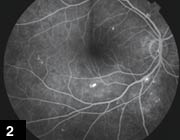Case report: Central serous chorioretinopathy in association with systemic lupus erythematosus
Is the chorioretinopathy a function of the disease or the treatment?
There is debate regarding the etiology of central serous chorioretinopathy in systemic lupus erythematosus. The increased permeability of the choroid may be a result of the systemic immune process or the glucocorticoid treatment. Proposed treatment options include focal laser, continuing systemic steroids or conversely weaning systemic steroids and replacing them with steroid sparing agents and photodynamic therapy.
Case report
A 50-year-old woman was first diagnosed with systemic lupus erythematosus (SLE) at age 16. She has suffered multiple systemic complications, including polyarthritis, nephropathy, multiple early miscarriages in early adult life and antiphospholipid syndrome resulting in numerous transient ischemic attacks. As a result, she has been treated with prednisone since age 17.
She initially presented at age 48 with a serous detachment of her left macula with visual acuity 20/10 in the right eye and 20/200 in the left. Over the next months, the detachment at her left macula gradually resolved with conservative treatment. However, several smaller peripheral neurosensory detachments occurred, but they did not affect her vision.

Serous detachment below right macula in patient with SLE.

Angiogram demonstrating hot spot and slow leak in serous detachment below right macula in patient with SLE.
Images: Rofail M, Lee LR

OCT through fovea and superior edge of serous of resolving serous detachment below right macula in patient with CSR.
At age 50, she presented with a right superior scotoma and serous detachment below her right macula. Her visual acuity at this time was 20/15 in the right eye and 20/30 in the left. This is again being managed conservatively. Due to several manifestations of long-term systemic steroids, her prednisone is being weaned and replaced with azathioprine, a steroid sparing agent.
Discussion
There are two proposed mechanisms for the development of central serous chorioretinopathy (CSR) in SLE.
Due to the systemic immune process, an immune mediated focal ischemia of the choroids occurs, resulting in ischemia of the overlying retinal pigment epithelium (RPE). This leads to a breakdown of the blood retinal barrier and leak of choroidal fluid and subsequent neurosensory retinal detachment.
Glucocorticoids are thought to play a role in independently damaging the ability of the RPE to transport ions. So systemic steroid treatment could directly result in leak of choroidal fluid and neurosensory detachment itself.
Consequently, there is some controversy as to what treatment for CSR in SLE is appropriate. Some studies advocate focal laser combined with systemic steroid to treat the choroidal inflammation, while others maintain that the condition fails to improve until systemic steroids are ceased.
We propose that when CSR in SLE is sight threatening and does not resolve with conservative management, systemic steroids should be weaned and replaced with a steroid sparing agent such as azathioprine. Conventionally, focal laser is applied to hot spots of peripheral lesions, and we are currently conducting trials on photodynamic therapy for the treatment of persistent central lesions with promising results.
For Your Information:References:
- Marc Rofail, MBBS, and Lawrence R. Lee, MBBS, FRACS, FRANZCO, can be reached at City Eye Centre, Level 10, 135 Wickham Terrace, Brisbane 4000, Australia; 07-3831-6888; e-mail: nmrofail@ihug.com.au.
- Cunningham ET, Alfred PR, Irvine AR. Central serous chorioretinopathy in patients with systemic lupus erythematosus. Ophthalmology. 1996;103(12):2081-2090.
- Shimura M, Tatehana Y, Yasuda K, et al. Choroiditis in systemic lupus erythematosus: Systemic steroid therapy and focal laser treatment. Jpn J Ophthalmol. 2003;47(3)312-315.
- Gass JDM, Little H. Bilateral bullous exudative retinal detachment complicating idiopathic central serous chorioretinopathy during systemic corticosteroid therapy. Ophthalmology. 1995;102(5):737-747.
